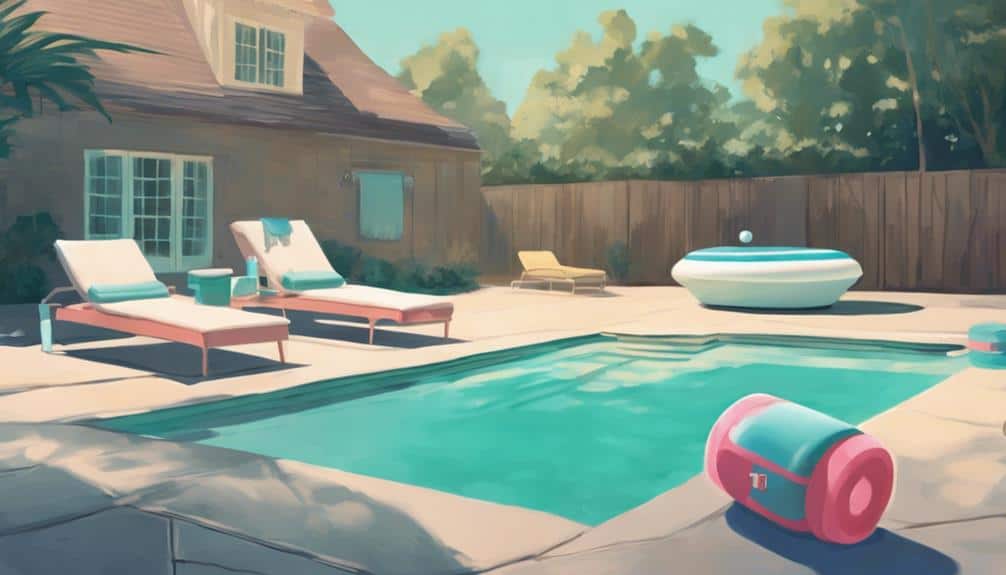After shocking your pool, wait 8-24 hours before swimming to allow the high dose of oxidizer to dissipate and chlorine levels to stabilize. This guarantees a safe and healthy swimming environment. During this time, the shock treatment eliminates contaminants, and chlorine levels return to a safe range. Premature swimming can lead to skin and eye irritation, respiratory issues, and allergic reactions. By waiting, you'll avoid these risks and secure a fun, safe swim. Want to know more about maintaining a safe pool environment and avoiding common mistakes?
Key Takeaways
• Wait 8-24 hours after shocking before swimming to ensure chlorine levels stabilize and chemicals dissipate.
• Shocking elevates chlorine levels, and waiting allows them to return to a safe range of 1-4 ppm.
• Premature swimming can cause skin and eye irritation, respiratory issues, and allergic reactions due to high chlorine levels.
• Testing chlorine and pH levels after shocking is crucial to ensure a safe swimming environment.
• Follow manufacturer's instructions and wait the recommended time after shocking to avoid health risks and ensure a safe swim.
What Is Pool Shock Treatment?
When you conduct a pool shock treatment, you're fundamentally introducing a high dose of oxidizer into the water to eliminate built-up contaminants and impurities. This process, also known as superchlorination, is essential for maintaining pool water quality and preventing waterborne illnesses.
By adding chemicals like chlorine, you're effectively raising free chlorine levels to guarantee the water is safe for swimming. Common shock treatment chemicals include calcium hypochlorite and chlorinated isocyanurates, which work to break down organic matter in the pool.
As a result, you can rest assured that your pool water is clean and free from harmful bacteria and algae. Pool shock treatment is an important step in pool maintenance, and understanding its purpose is critical for pool owners who want to provide a safe and healthy swimming environment.
How Shocking Affects Chlorine Levels
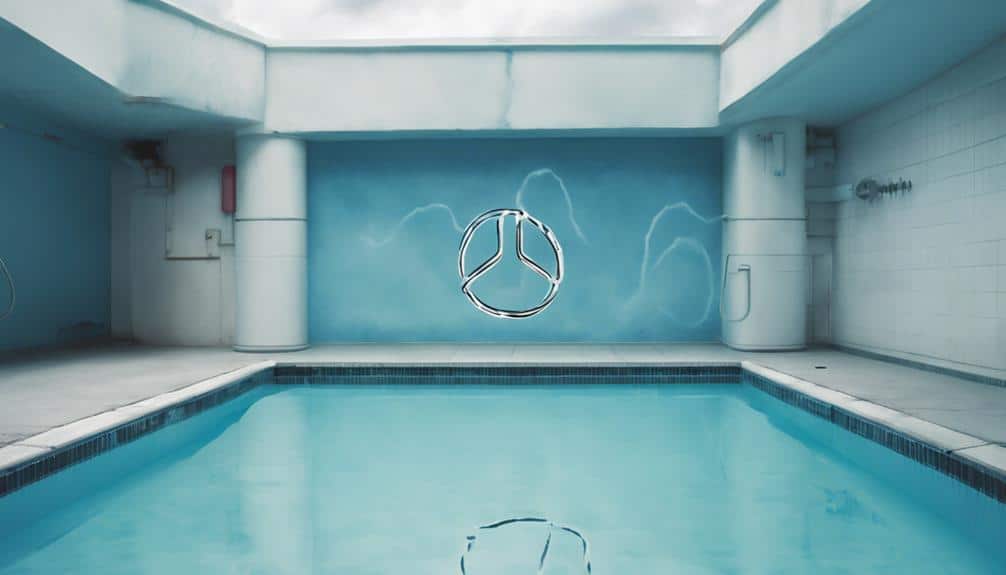
By introducing a high dose of oxidizer into the pool water, shocking greatly boosts free chlorine levels to sanitize the water and eliminate bacteria and contaminants. This rapid increase in chlorine levels is important for maintaining a safe and healthy swimming environment.
However, it's important to understand how shocking affects chlorine levels to make sure you wait to swim until it's safe.
Here are some key points to keep in mind:
- Ideal chlorine levels: After shocking, free chlorine levels should range between 1-4 parts per million for safe swimming.
- Chlorine shock: This process quickly elevates chlorine levels to sanitize the pool water effectively.
- Waiting period: It's necessary to wait at least 8 hours after shocking to allow chlorine levels to drop back to a safe range.
- Test the water: Use a chemical test kit to confirm chlorine levels are suitable for swimming after shocking.
Safe Waiting Period for Swimmers

After allowing the shock treatment to sanitize your pool water, you'll need to wait for a safe period before swimming can resume. It's important to wait at least 8-24 hours after shocking a pool to make sure the chemicals dissipate and chlorine levels stabilize. This waiting period is necessary to prevent any health risks associated with swimming in chemically imbalanced water.
During this time, it's important to test the water for balanced pH and chlorine levels to guarantee a safe swimming environment. If you've performed superchlorination or severe algae treatments, it's recommended to wait longer to avoid any potential health hazards.
Always follow the manufacturer's instructions and safety guidelines to ensure a safe and enjoyable swimming experience post-shocking. By waiting the recommended time, you can confidently reopen your pool, knowing that the water is safe for swimmers.
Risks of Swimming Too Early

Swimming too early after shocking your pool can expose you to a plethora of risks, from skin and eye irritation to respiratory issues and allergic reactions. You might think you're ready to immerse in, but premature swimming can have serious consequences.
Here are some risks to take into account:
- Skin and eye irritation: High chlorine levels can cause redness, itchiness, and discomfort.
- Respiratory issues: Inhaling chemical fumes can lead to respiratory problems, such as coughing, wheezing, and shortness of breath.
- Chemical burns and allergic reactions: Exposure to pool-shocking chemicals can cause skin burns, blisters, and allergic reactions, which can be painful and uncomfortable.
- Environmental impact: Swimming too early can also harm the environment, as chemicals can contaminate nearby water sources and harm aquatic life.
Shocking Your Pool Safely
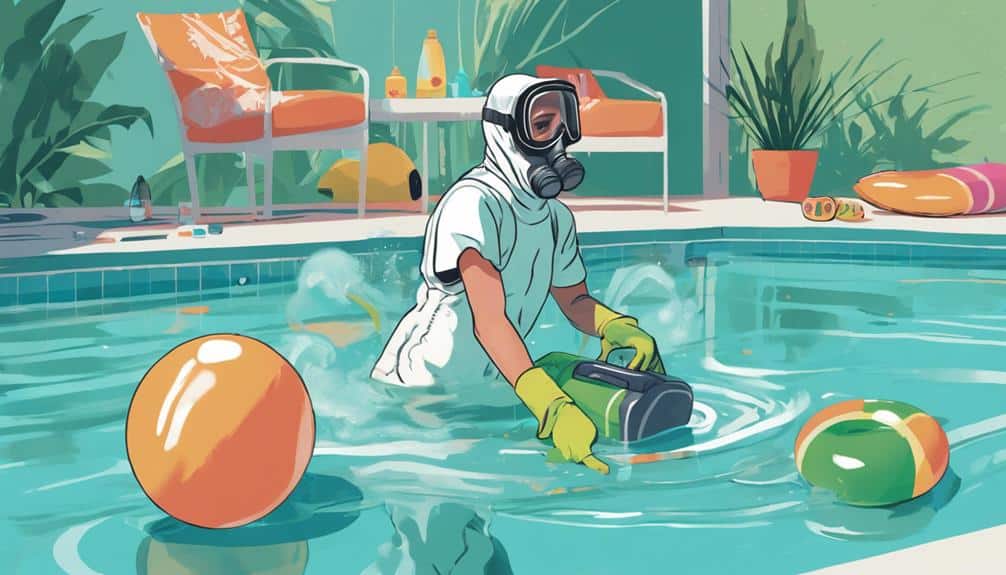
You must take a methodical approach to shocking your pool to guarantee a safe and healthy swimming environment, as improper shocking can lead to hazardous conditions. When you shock your pool, you're introducing high levels of chlorine to eliminate contaminants and restore water balance.
However, this process can leave behind high chemical residues that can irritate skin and eyes. To make sure safe swimming after shocking, make sure to wait a sufficient amount of time, usually between 8-24 hours, depending on the type and amount of shock treatment used.
Pool shock depends on various factors, including the size of your pool, the type of shock treatment, and the initial chlorine levels. Long after shocking, it's important to test chlorine and pH levels before swimming to prevent skin and eye irritation.
Make sure to follow the manufacturer's instructions and maintain proper filtration to guarantee safe chemical levels. By doing so, you can swim after shocking, safe in the knowledge that your pool is safe to swim in.
When to Use Pool Shock Treatment
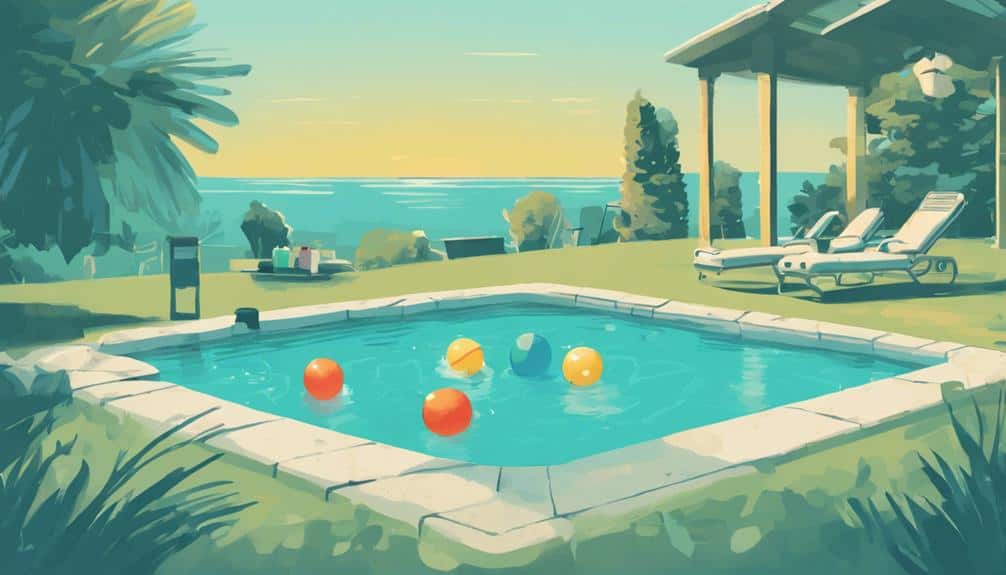
When determining when to use pool shock treatment, you'll want to check your chlorine levels regularly, as low levels can indicate the need for shocking.
You'll also need to time your shock dose correctly to guarantee maximum effectiveness.
Chlorine Level Check
A simple dip test or pool test strip reveals the free chlorine level, a critical indicator of when to administer pool shock treatment. As a pool owner, it's vital to regularly monitor free chlorine levels to make sure the water is safe for swimmers.
When levels drop below 1.0 ppm, it's necessary to shock the pool to prevent bacterial and algal growth.
Here are some key points to keep in mind when performing a chlorine level check:
- Low free chlorine levels indicate the presence of contaminants, requiring immediate shock treatment.
- Testing for chlorine levels is important before deciding to shock a pool for effective sanitation.
- Regular monitoring and adjustment of free chlorine levels can prevent the need for frequent pool shocking.
- Shock treatment helps maintain the proper balance of free chlorine, ensuring safe swimming conditions.
Shock Dose Timing
After administering pool shock treatment, it's important to time it correctly to achieve the best results and guarantee swimmer safety. You should apply pool shock in the evening to prevent the sun from burning off the chlorine too quickly.
When it comes to swimming, you'll want to wait at least 8 hours after shocking your pool to make sure safe chlorine levels. However, if you're dealing with severe algae or contamination issues, you may need to wait up to 24 hours post-shocking before taking a dip.
Proper circulation and filtration are key during this time, so make sure to maintain them for at least 8 hours after applying pool shock. If you do need to shock your pool during the day, consider using stabilized chlorine shock to prevent rapid dissipation of chlorine due to sunlight exposure.
How Long Does Shock Take

When you shock your pool, you're probably wondering how long it'll take for the process to complete.
The shock dose timing and chlorine reaction rate are vital factors in determining how long you'll need to wait before it's safe to swim.
Shock Dose Timing
You'll typically need to wait anywhere from 8 to 24 hours for the shock dose to dissipate and balance out in the water before it's safe to swim. The waiting time after shocking a pool can vary based on the type and amount of shock used. It's important to follow the manufacturer's instructions and wait for the chemicals to dissipate to avoid any safety risks.
Here are some key considerations to keep in mind:
- Type of shock: The type of shock used can affect the waiting time. Some shocks may take longer to dissipate than others.
- Amount of shock: The amount of shock used can also impact the waiting time. A larger dose may require a longer waiting period.
- Chlorine and pH levels: It's crucial to test chlorine and pH levels before swimming to make sure they're within safe ranges post-shocking.
- Swim safely: Swimming too soon after shocking a pool can lead to skin, eye, and respiratory irritation due to high chlorine concentrations.
Chlorine Reaction Rate
The reaction rate of chlorine shock in your pool can vary greatly, but on average, it takes around 8 hours for the shock to dissipate and reach safe swimming levels. Factors like pool size, amount of shock added, and water temperature can influence the reaction rate of chlorine shock.
Waiting for the chlorine shock to fully dissipate is important to prevent skin, eye, and respiratory irritation when swimming. You shouldn't rush back into the pool too quickly, as this can lead to uncomfortable and potentially harmful reactions.
Instead, test the water with a pool test kit to determine when chlorine levels are safe for swimming after shocking the pool. Proper filtration and circulation of water post-shocking can also help speed up the process of chlorine shock dissipation for safe swimming conditions.
What Happens If You Swim Too Early

Swimming prematurely after shocking exposes you to a barrage of health risks, including skin and eye irritation, respiratory issues, and even allergic reactions. By diving in too soon, you're basically bathing in a chemical cocktail that can wreak havoc on your body.
Here are just a few dangers you'll face if you swim too early:
- Skin and eye irritation: High chlorine levels can cause painful burns, itchiness, and redness.
- Respiratory issues: Inhaling shock chemicals can lead to coughing, wheezing, and shortness of breath.
- Allergic reactions: Some people may be more sensitive to pool chemicals, which can trigger severe reactions.
- Long-term health hazards: Repeated exposure to these chemicals can have lasting effects on your health, including increased risk of certain diseases.
Post-Shocking Pool Maintenance Tips

Now that you've allowed the shock treatment to circulate, it's vital to monitor your pool's chemistry to guarantee a safe and healthy swimming environment.
You'll want to regularly check chlorine levels, monitor pH balance, and test alkalinity levels to prevent any potential imbalances.
Check Chlorine Levels
After shocking your pool, you must test the chlorine levels to guarantee they fall within the safe range of 1.0 to 4.0 parts per million, allowing you to swim safely and securely. This vital step ensures that the chlorine levels aren't too high or too low, which can cause skin, eye, and respiratory issues.
Here are some essential tips to keep in mind:
- Test chlorine levels regularly: Make sure they fall within the safe range of 1.0 to 4.0 parts per million.
- Wait 24 hours: Allow the chemicals to dissipate before swimming to prevent any adverse effects.
- Monitor pH levels: Maintain proper pH levels between 7.2 and 7.8 for a safe swimming environment.
- Follow manufacturer instructions: Adhere to the recommended guidelines for post-shocking pool maintenance to ensure a safe and enjoyable swimming experience.
Monitor Ph Balance
After completing the shock treatment for your pool, it is important to monitor the pH balance to prevent discomfort and health risks for swimmers. Testing pH balance after shocking a pool is essential to guarantee safe swimming conditions. Proper pH levels between 7.2-7.8 are essential for maintaining water quality post-shocking.
| pH Level | Effects on Swimmers |
|---|---|
| < 7.2 | Skin and eye irritation, corrosion of pool equipment |
| 7.2-7.8 | Safe swimming conditions, best water quality |
| > 7.8 | Eye irritation, skin discomfort, scaling on pool surfaces |
Imbalanced pH levels can lead to discomfort and health risks for swimmers. Monitoring pH balance helps prevent skin and eye irritation when swimming in a recently shocked pool. Regularly checking and adjusting pH levels post-shocking is necessary for a healthy pool environment. By maintaining the best pH levels, you can ensure safe and enjoyable swimming experiences for everyone.
Test Alkalinity Levels
By maintaining a healthy pH balance, you've set the stage for peak water quality, and now it's time to focus on testing alkalinity levels, a critical component of post-shocking pool maintenance that helps stabilize pH levels and guarantee chlorine's effectiveness in disinfecting the pool.
Testing alkalinity levels is essential for maintaining proper water balance. Alkalinity helps stabilize pH levels and prevent rapid changes in acidity.
Here are some key takeaways to keep in mind:
- Important alkalinity levels: Aim for 80-120 ppm to make sure chlorine works effectively in disinfecting the pool.
- Low alkalinity risks: pH fluctuations and corrosion can occur if alkalinity levels are too low.
- High alkalinity risks: Cloudy water can result from excessively high alkalinity levels.
- Regular monitoring: Regularly check and adjust alkalinity levels to contribute to a safe and enjoyable swimming environment.
Is it Safe to Swim in a Pool After it Has Been Shocked?
Yes, swimming after pool shocking is safe. Once the pool has been shocked, it’s essential to wait until the chlorine levels have returned to normal before swimming. This usually takes about 24 hours. It’s important to follow the manufacturer’s guidelines on when it’s safe to swim after shocking the pool.
Pool Safety Precautions to Take
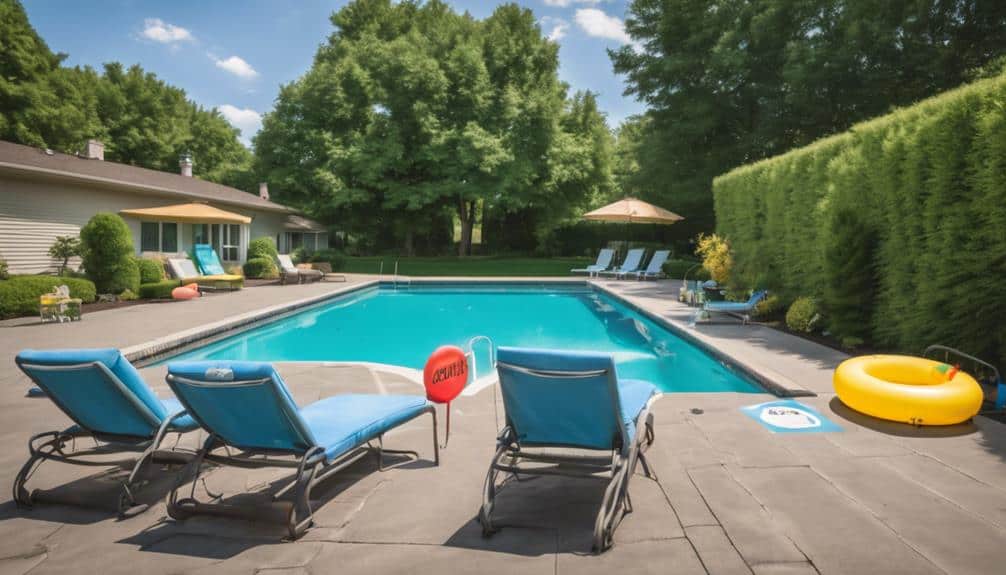
When you've shocked your pool, it's crucial to take certain precautions before diving back in to guarantee a safe and healthy swimming experience. You must wait at least 8 hours after shocking to allow chemicals to dissipate, and test chlorine and pH levels to ensure water safety. Failing to do so can lead to skin and eye irritation. Always follow the manufacturer's instructions for pool shock products to ensure safe swimming.
To further minimize health hazards, maintain proper filtration and shower before entering the pool. This will help remove any remaining chemicals and contaminants from your body.
| Precaution | Why | Consequence of Failure |
|---|---|---|
| Wait 8 hours after shocking | Allow chemicals to dissipate | Skin and eye irritation |
| Test chlorine and pH levels | Ensure water safety | Skin and eye irritation |
| Follow manufacturer's instructions | Ensure safe swimming | Health hazards |
| Maintain proper filtration | Remove contaminants | Health hazards |
| Shower before entering pool | Remove remaining chemicals | Health hazards |
Ensuring a Safe Swimming Environment

You can guarantee a safe swimming environment by implementing a few key measures beyond waiting and testing. A safe and healthy swimming experience relies on a combination of proper pool maintenance and swimmer responsibility.
To establish a safe and enjoyable swimming experience, follow these essential safety measures:
- Maintain proper filtration: Regularly clean and maintain your pool's filtration system to prevent the buildup of harmful chemicals and bacteria.
- Shower before swimming: Rinsing off before entering the pool helps reduce the amount of dirt and contaminants that can affect chlorine levels and cause skin irritation.
- Adhere to recommended waiting times: Wait the recommended 8-24 hours after shocking your pool to allow chlorine levels to stabilize, reducing the risk of skin and eye irritation.
- Conduct regular water testing: Regularly test your pool's water chemistry to ensure pH and chlorine levels are within a safe range, preventing potential health hazards.
Frequently Asked Questions
How Long After Shocking a Pool Is It Safe to Swim?
When you shock your pool, you're probably wondering how long you'll have to wait before diving back in. The answer depends on the type and amount of shock treatment used.
Typically, you'll want to wait 8-24 hours to make sure chlorine levels are safe. But it's important to test the water's pH and chlorine levels before swimming to avoid skin and eye irritation.
How Long Does It Take for Pool Water to Clear up After Shocking?
You're wondering how long it takes for pool water to clear up after shocking. The answer depends on several factors, including pool size, chemical levels, sunlight exposure, water temperature, and circulation speed.
Generally, it can take anywhere from 8 to 24 hours for the water to clear. You can speed up the process by ensuring proper filtration and circulation, and testing the water clarity and chemical levels regularly.
How Long After Putting Chlorine in the Pool Can You Swim?
When you add chlorine to your pool, you're probably excited to jump in, but wait! It's important to allow the chemicals to dissipate.
Typically, you should wait 8-24 hours after shocking your pool before swimming. However, this timeframe may vary depending on the type of shock used and your pool's size.
Always test chlorine and pH levels before giving the all-clear for swimming to guarantee a safe and healthy experience.
How Long to Keep Pool at Shock Level?
As you gaze into the crystal-clear waters, imagine a medieval knight's shield emblazoned with a timer, counting down the hours until the pool is safe for swimming.
To keep your pool at shock level, you should wait at least 8 hours, allowing chlorine to vanquish contaminants.
Monitor chlorine levels closely, as the duration may vary depending on the type of shock used and contamination severity.
